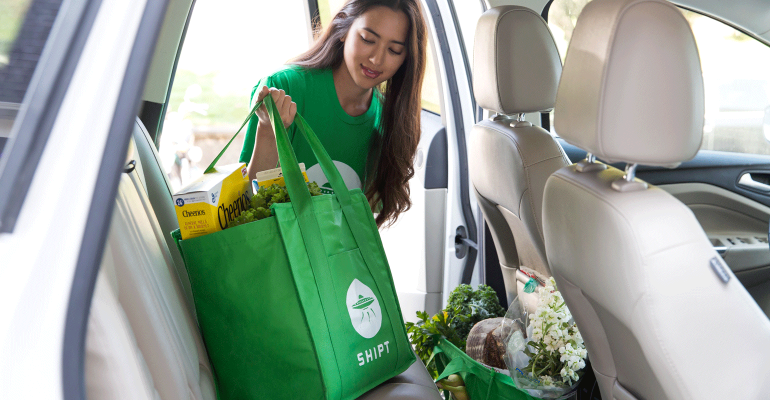As food and grocery retailers grapple with unsustainable last-mile delivery models, a rising percentage of consumers seek free shipping for online orders, new research shows.
According to the Capgemini Research Institute, retailers are absorbing a sizable chunk of last-mile delivery costs for online grocery orders. The average cost incurred per online order is $10.10, yet the average cost recovered from customers per online order is $8.08, the researcher reported in its “Last-Mile Delivery Challenge” study, released last week. Consumers are only willing to pay an average of $1.40 per online order for delivery.
Meanwhile, shoppers increasingly expect free delivery of items they purchase online, the National Retail Federation said. NRF’s latest “Consumer View” survey, released this week, found that 75% of the roughly 3,000 U.S. adults polled want delivery to be free even on orders less than $50, up from 68% a year ago.
Tim Bridges, global sector leader for consumer products, retail and distribution at Capgemini, noted that consumers also have had their ups and downs with online delivery service.
"Today, customers are neither satisfied with the quality of delivery services nor willing to bear the total cost of last-mile delivery,” Bridges explained. “Therefore, the dilemma facing retailers is to provide last-mile delivery services that customers value, without damaging their own profitability.”
Among supply chain executives surveyed for the Capgemini study, 99% said they think online delivery orders are less profitable — by an average of 19% — versus in-store purchases. The vast majority (97%) also believe their current last-mile delivery approach isn’t sustainable for a large-scale rollout. In an analysis of a hypothetical U.S. grocery retailer, Capgemini calculated that net profit could fall by 26% (from a net profit margin of 3.48% to 2.58%) from 2018 to 2021 unless delivery capabilities are improved.
Currently, companies are charging customers only 80% of the overall delivery cost, according to Capgemini’s report, which surveyed 2,874 consumers in North America and Europe and executives from 500 grocery retailers and consumer product firms. And delivery is the most expensive part of the supply chain, accounting for 41% of costs, over two to three times as much compared with warehousing (13%), sorting (20%) and parceling (16%). Just 1% of customers indicated a willingness to absorb the total cost incurred for last-mile deliveries.
NRF’s study revealed that many consumers now assess shipping costs even before getting to the checkout page. Of those surveyed, 65% said they look up free-shipping thresholds before adding items to their online shopping carts.
By age range, Baby Boomers (born 1946-1964) demand free shipping the most, with 88% expecting it, versus 77% for Generation X (1965-1980), 61% for Millennials (1981-1994) and 76% for Generation Z (1995 and later).
Shoppers, too, want to receive their orders quickly. Thirty-nine percent expect two-day shipping to be free, and 29% indicated that they’ve abandoned a purchase because two-day shipping wasn’t free, NRF found.
Seventy percent of consumers aware of click-and-collect service — buy online, pick up in-store — had tried it, primarily to avoid paying for shipping. Most using click-and-collect pick up their orders at checkout (83%), NRF said. But as pickup options expand, 63% said the would like to use curbside pickup (tried so far by 27%), 56% want orders delivered to the trunk of their cars (tried by 19%) and 50% want to collect purchases from a locker (tried by 16%).
“Consumers want free delivery, and they’re willing to meet retailers halfway to get it,” commented Mark Mathews , vice president for research development and industry analysis at NRF. “If we can get their purchase to the store, they’ll come pick it up, if that’s what it takes to avoid a delivery charge. And once they’re in the store, they are very open to seeing what else the retailer has to offer. This is part of the growing evidence that consumers see retail as retail regardless of how they make their purchases and get them.”
Capgemini’s study notes that the demand for online grocery delivery is clear. In the United States, for example, 38% of consumers received deliveries once a week or more from grocery retailers (40% across all areas examined), and that percentage is expected to rise to 52% by 2021 (55% for all areas).
Forty percent of customers deem delivery services as a must-have when buying food and grocery products, and 20% report they will switch retailers if this service isn’t offered. And retailers that do provide delivery reap benefits: 74% of satisfied customers say they’ll boost their spending by as much as 12% at retailers where they make frequent purchases, according to Capgemini’s report. Conversely, consumers won’t recommend retailer delivery services with high fees (59%), no same-day delivery (47%) and frequent late deliveries (45%).
Retailers can improve online grocery fulfillment — and their margins — by increasing store-based deliveries by 50%, using dark stores as delivery/pickup locations, using lockers for delivery/pickup, and employing backroom automation. The Capgemini study estimated that latter could hoist profits up to 14% by cutting the cost of delivery and click-and-collect service.
“If done right, their last-mile experience can win customer satisfaction, and retailers stand to gain loyalty, increased purchase value and frequency,” Bridges added, “while mitigating profitability risk through automation and optimization of fulfillment locations."





